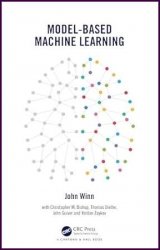Model-Based Machine Learning
- Добавил: literator
- Дата: 7-11-2023, 06:33
- Комментариев: 0
 Название: Model-Based Machine Learning
Название: Model-Based Machine LearningАвтор: John Winn
Издательство: CRC Press
Год: 2024
Страниц: 428
Язык: английский
Формат: pdf (true)
Размер: 30.8 MB
Today, Machine Learning (ML) is being applied to a growing variety of problems in a bewildering variety of domains. When doing machine learning, a fundamental challenge is connecting the abstract mathematics of a particular Machine Learning technique to a concrete, real-world problem. This book tackles this challenge through model-based Machine Learning. Model-based Machine Learning is an approach which focuses on understanding the assumptions encoded in a ML system, and their corresponding impact on the behaviour of the system. The practice of model-based ML involves separating out these assumptions being made about a real-world situation from the detailed mathematics of the algorithms needed to do the ML. This approach makes it easier to both understand the behaviour of a ML system and to communicate this to others. Much more detail on what model-based Machine Learning is and how it can help are described in the introduction chapter entitled “How can Machine Learning solve my problem?”.
This book is unusual for a Machine Learning text book in that we do not review categories of algorithms or techniques. Instead, we introduce all of the key ideas through case studies involving real-world applications. Case studies play a central role because it is only in the context of applications that it makes sense to discuss modelling assumptions. Each case study chapter introduces a real-world application and solves it using a model-based approach. In addition, a first tutorial chapter explores a fictional problem involving a murder mystery.
Each chapter also serves to introduce a variety of Machine Learning concepts, not as abstract ideas, but as concrete techniques motivated by the needs of the application. You can think of these concepts as the building blocks for constructing models. Although you will need to invest some time to understand these concepts fully, you will soon discover that a huge variety of models can be constructed from a relatively small number of building blocks. By working through the case studies in this book, you will learn what these components are and how to use them. The aim is to give you sufficient appreciation of the power and flexibility of model-based approach to allow you to solve your Machine Learning problem.
Who this book is for:
This book is intended for any technical person who wants to use Machine Learning to solve a real-world problem or who wants to understand why an existing Machine Learning system behave the way it does. The focus of most of the book is on designing models to solve problems arising in real case studies. The final chapter “How to read a model” looks instead at using model-based machine learning to understand existing Machine Learning techniques. Some more mathematically minded readers will want to understand the details of how models are turned into runnable algorithms. We have separated these parts of the book, which require more advanced mathematics, into deep-dive sections.
Скачать Model-Based Machine Learning
Внимание
Уважаемый посетитель, Вы зашли на сайт как незарегистрированный пользователь.
Мы рекомендуем Вам зарегистрироваться либо войти на сайт под своим именем.
Уважаемый посетитель, Вы зашли на сайт как незарегистрированный пользователь.
Мы рекомендуем Вам зарегистрироваться либо войти на сайт под своим именем.
Информация
Посетители, находящиеся в группе Гости, не могут оставлять комментарии к данной публикации.
Посетители, находящиеся в группе Гости, не могут оставлять комментарии к данной публикации.
